The W trek is a five day hike through the Torres del Paine National Park in Chilean Patagonia. It is the most popular of three hikes known as the W, Q and O named after the shape that they form on a map. Compared to hikes in some other areas of South America these are popular because they are easy enough to be tackled by people with relatively little long-distance hiking experience and they can be completed relatively cheaply as they do not require a guide. However probably the biggest reason for their popularity is the variety of scenery that can be experienced along the way.
We opted for the W trek in 5 days (the most common choice) and chose the West to East direction of the walk.
Our itinerary for the walk and preparation was as follows:
Two weeks before the trek – book camping at Vertice Grey through Vértice and Camping Los Cuernos through Fantástico Sur.
Two days before the Trek – arrive in Puerto Natales after crossing the border from Argentina. We should have also gone straight to the CONAF office in Puerto Natales to book Campamento Italiano and Campamento Torres but unfortunately we didn’t realise this until it after it closed.
The day before the trek – buy normal food and dried fruit and vegetables, rent gear and attend the 3pm talk at Base Camp next to Erratic Rock. We then drove to the campsite at Rio Serrano in order to be closer to the park the next morning.
Day 1 of the trek – while most people were on the bus from Puerto Natales to the park we got up early to drive the van to Hotel Las Torres where we could leave it for the 5 days of the trek. This was also where we would finish so it made life really easy for us on the last day. This was all a bit of a rush in the end but we just made it to the shuttle thanks to some appalling (by which I mean excessively fast) driving from me. We then took the shuttle to Laguna Amarga (where we reserved Campamento Torres thanks to our failure to do it in Puerto Natales) and joined the regular bus when it passed. This took us to Pudeto where we caught the Catarmaran to Paine Grande. In Paine Grande we were able to reserve our final campsite, Campamento Italiano and we then walked up to Camping Grey where we pitched our tent and took a short walk up to the Mirador to see the Glacier. We were lucky with the weather for most of the day although it rained a little after we arrived at the campsite. The walk was only 11km on this day but we were just getting used to carrying around 15kg on our back for long distances, so by the time we got to the campsite we were sore and tired. We’d decided to push the boat out in terms of dinner for the first night because we would only have to carry the ingredients a little way, so we cooked bangers and mash with veggie sausages, garlic mash and onion gravy. Although it took a little while to cook on a single gas stove we got plenty of admiration from the other campers when we pulled out a fresh onion and even the mash from dehydrated potatoes (more commonly known in the UK as Smash) came out tasting pretty good. We’d met some other hikers on the way, Claire and James an English couple, and Katie another English girl so we now had a nice group of 6 people. The campsite itself was fine but there were far too many people for the facilities, a bit of a shock after all of the quiet and near-deserted campsites we’d stayed in over the last month.
Day 2 of the trek – we got up around 8am and left the campsite just after 9am having eaten and packed up the tent. We’d walked slightly slower than the times shown on the map on the first day, and we wanted to pass Paine Grande before the Catarmaran arrived so that we’d have a quieter day. We nearly managed that but stopped at Paine Grande for lunch and watched as the new hikers from the Catarmaran arrived and queued to book Campamento Italiano. In the end although we didn’t beat them, they all seemed to disperse in different directions so the walk to Italiano was not too busy. We arrived at Italiano in light rain and being one of the free campsites and also very popular it had limited facilities (two frequently blocked toilets and a river to retrieve water from) and also limited places to pitch our tent. We managed to find a spot at a slight angle with a tree root under a corner but it was the best we could do. The cooking area was tiny for the number of people needing to use it but we eventually secured a space on a bench and cooked dinner. We had brown rice with dried mushrooms, onions and garlic. Once it was ready the rice was delicious, flavoured by the dehydrated vegetables it became more of a risotto and again admired by those around us who mostly ate rice or pasta from a packet. We had plenty of time for this admiration however as the brown rice took ages to cook leaving us absolutely starving. Since it was pretty cold and wet we went straight to bed after dinner.
Day 3 of the trek – it had rained all through the second night and had been pretty windy. We got up in the wind and rain and made breakfast. James and Claire and Katie had all discovered that their tents were pretty rubbish, letting in plenty of water from both above and below, however ours was much better so at least our dry clothes were still dry. Luckily just after breakfast a ray of sunshine shone through the trees and I looked up to see a little blue sky. By the time we left for the day’s walk it was sunny although still very windy. Our third day’s walk was up and back down the central stick of the W and since we would pass back through the campsite we were able to leave our tent erected with our belongings inside it, carrying only a day bag with water and lunch. The walk started slowly with a rocky path and river crossings but soon enough we were at the halfway point. Shortly after that we suddenly realised that we’d lost the trail, along with a couple of Dutch girls we’d met along the way (I have no idea why we seem to attract Dutch girls, I can only assume that they are drawn to my orange backpack) I used some of my precious battery life to boot up my phone and used GPS to plot us a route back to the path. Just before we started the final ascent to Mirador Británico and the end of the walk we spotted a male, female and suckling baby Huemul deer in the woods. A few minutes after this we were eating our sandwiches on Mirador Británico admiring the view of the mountains, valley and glacier around us.
The walk down was much quicker and we made it back to Campamento Italiano surprisingly quickly. We then had to pack our (now dry) tent and bags and walk 2.5 hours to Los Cuernos, our campsite for the third night. This was hard work after a long day but our reward was the nicest campsite of the trip with ample clean toilets and a bigger (though still packed) cooking area, plus a shop where we bought a couple of expensive beers. The nights dinner was pasta and sauce but we added our remaining onion, half a pepper and some dried chilli to the sauce to make it a little tastier.
That night we had some of the strongest winds I’d ever experienced. Katie’s tent was destroyed by the wind and she had to go and sleep in someone else’s. Luckily before bed I’d checked all of our pegs and guy ropes so despite blowing around us all night we were fine. We had to lend some spare shoelaces to a neighbouring camper to secure his tent!
Day 4 of the trek – we woke to find that although the tent had survived the night, a tree branch that hung low over our platform had rubbed against the tent in the wind and there was now a hole in the outer. I stuck some duct tape over the hole and we packed up for our day’s walk. The fourth day on our route was the longest as we had to travel a good distance, gain a lot of height and we had to do it all with our backpacks. The wind was stronger than I’ve ever walked in. After about an hour we came to an open area where we needed to cross a stream. As we crossed a gust of wind came across and we all dropped down to the rocks to cling on for dear life. Unfortunately I was less lucky and the waterproof cover was pulled off my bag and our two raincoats that were in the top of it flew off. I ran after the coats and managed to retrieve mine about 20 metres away on the ground and Alex’s a little further away having landed in the stream. James thought he’d seen where the cover had gone and he ran off to find it eventually returning from where it had landed 200 metres away. While we were waiting the wind lashed up constantly knocking Claire off her feet. I was wearing a shirt and the wind was strong enough to repeatedly rip it open so that I had to button it back up at least three times. Once we were all back together we made a dash up the hill and into some cover.
The rest of our day was not nearly as eventful. The wind continued to blow us around and we were all knocked off our feet or forced to drop down to the ground several times. Although our campsite for the night was Campamento Torres there was a refugio further down the mountain that we passed on the way up which had better facilities and a shop. On the path descending to the refugio I felt my right knee suddenly give way and it hurt to walk downhill from then onwards. After stocking up with biscuits and wine we left Chileno and climbed the last couple of hours to Campamento Torres, another free campsite but quieter and with much nicer toilets than at Italiano two nights previously. The next morning’s destination of Mirador Torres was closed due to high winds. We had another risotto like dish this time with white rice and I put a little finely chopped up pepper, a little cumin and some chilli flakes in to make it different to the previous one. We had an early start the next morning so we went to bed before 9pm when it was still light. We were so tired from the walk however that we all fell asleep almost immediately.
Day 5 of the trek – The alarm went off at 4:15 am. It was dark and cold. Luckily the rain had stopped and the wind had died down. We had to start walking at 4:45am so we immediately got out of bed, put on our headtorches and got out of the tent. It was pitch black outside but with the headtorches we could immediately see why we couldn’t hear rain, it was snowing! Our group gathered together (minus Katie as she hadn’t made it to the campsite the previous evening) and we set off up the hill. The walk was only 1km but with a 300 metre climb on a wet and rocky surface it took an hour. Every now and then we’d see the reflection of eyes in the darkness but it always turned out to be a fox and not a puma! Eventually we made it to the top, found a boulder to give us a little shelter, got out our roll mats and sleeping bags and climbed back in with the bottom of our sleeping bags protected by a bin liner. We warmed up and sat waiting for sunrise. As it slowly got lighter it became clear that it was actually snowing pretty heavily and that the Torres (towers) we obscured by fog. Realising that they weren’t going to get the picture perfect sunrise people started to leave (there were less than 30 there in total) but we sat for a little longer. Eventually the fog cleared a little and the sun shone an orange light onto one of the mountains. We never got a totally clear view, but we saw enough. When we could wait no longer because we were now getting very cold and wet from the snow, we packed up and headed back down. As we left the fog seemed to be getting thicker and we left with the mountains once again totally obscured. We were all freezing cold but the walk down helped to warm us up, as did the porridge that we made for breakfast back at camp. We quickly broke camp and headed back down the mountain, stopping for a rest at Chileno and then continuing down the mountain. My knee was hurting a lot but thankfully I was able to use my walking poles to take some of the weight off it and avoid further injury.
Before we knew it were we back at the van, exhausted but happy. We’d found Katie at Chileno where she’d been unable to continue due to the weather (she was behind us on the fourth day) and we gave everyone a lift back to the park entrance, arranging to all meet later for dinner.
We drove back to Puerto Natales stopping by a lake on the way to use our last food to make some pasta and sauce for lunch then returned to the same hostel/campsite we’d stayed in before the trek to get a warm shower, return equipment and drop off laundry.
In the evening we all met up at Base Camp for a few beers and one of the best pizzas we’ve had in South America.
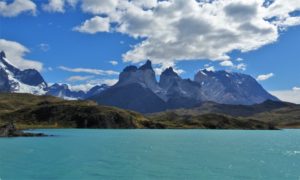
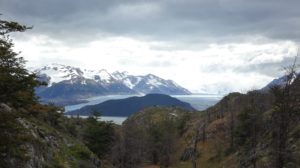
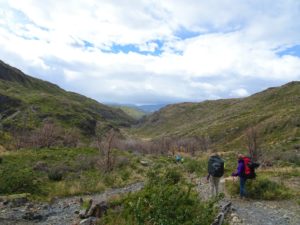
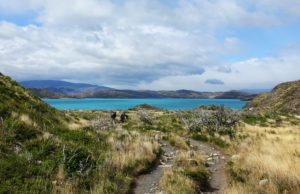
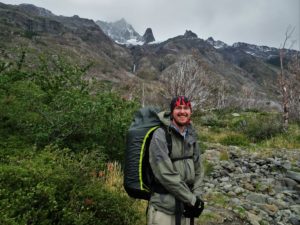
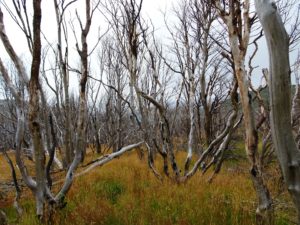
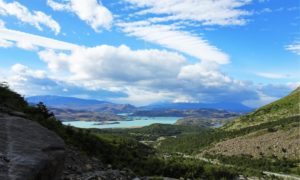
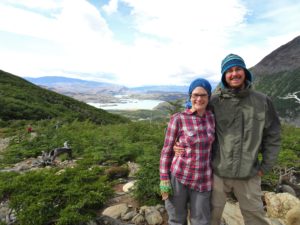
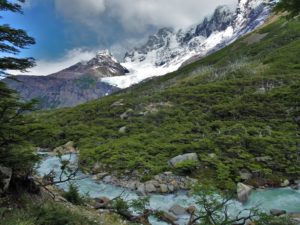
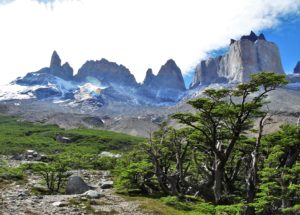
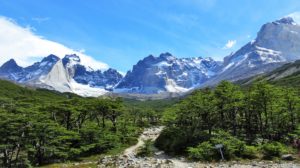
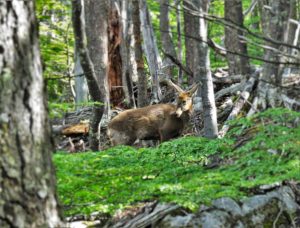

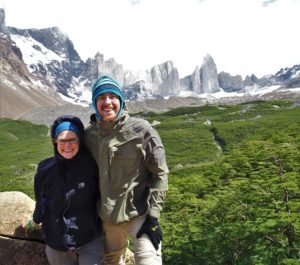
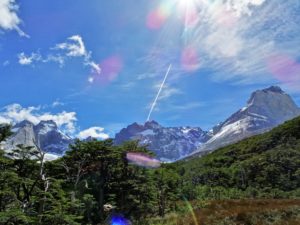
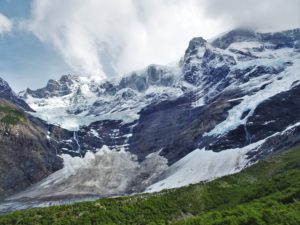
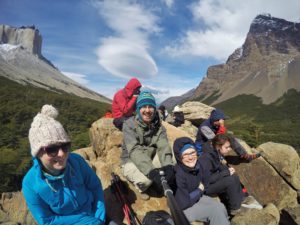
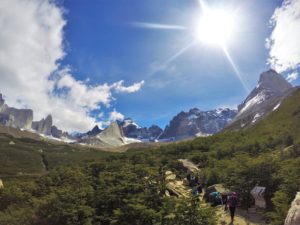
Looking back there are many things that we could have done differently, and although we were relatively well prepared there are many things that we wished we’d known or think that we actually did quite well! Some of our best and worst things are below, hopefully useful if you are thinking of doing this trek. Much of this was influenced by research beforehand and the briefing from Erratic Rock the day before.
The route – although this is personal preference the west to east route was a perfect balance with an easier first day to allow for travel there, the Torres saved for last, and the maximum use of the free campsites.
Booking – We booked the paid campsites a few weeks in advance which meant that we got our first choice and didn’t have to make any long detours. If I did it again I’d go straight to the CONAF office (one block south of Erratic Rock) on the day of arrival in Puerto Natales which would have saved booking Torres at Laguna Amarga and Italiano at Paine Grande. We didn’t even know that Italiano had to be booked as our research indicated it previously wasn’t possible.
Equipment – we each took a wet and a dry set of clothes and shoes. The wet set for walking in (including walking boots) and the dry set for the evenings. We took trainers to keep our feet warm in the evenings. I barely wore mine but know that I would have really appreciated them if my walking boots had got wet through! We religiously tried to keep the dry set of clothes dry so we always had something to put on if we got really cold. We also took a spare set of clothes in case it was really wet and we got everything else wet! We rented our sleeping bags, tent, sleeping mats and trekking poles. We rented nearly everything from Erratic Rock but the tent from Hostal Yagenhouse as Erratic Rock do not rent three man tents. Erratic Rock were excellent as were Yaganhouse (who Erratic Rock recommended to us). Our sleeping bags had a comfort temperature of -3 degrees and were perfect. We spoke to other people who had rented elsewhere and were cold at night and many others who had older tents that weren’t waterproof, or like Katie’s snapped in the wind. Since the conditions are pretty harsh for tents it is especially important that you have a decent tent, that is not too old, and that you always carefully peg it out and use all the guy ropes, as this is your best defence against getting soaking wet gear! We also packed all of our gear into black bin bags so that even if our bags got wet, our clothes and sleeping bags wouldn’t! Lastly we also took plenty of spare gas just because I really didn’t want to eat half cooked food out of fear of running out.
Food – this is probably where we had our best successes and worst mistakes. Our dinners were generally very good but the cooking areas in the campsites are so tight that longer cooking times were a pain. We really appreciated the fresh vegetables even though all we carried was an onion and two red peppers. If I did this again I’d take more fresh veg and skip the brown rice! For breakfasts we had porridge (oatmeal to Americans) every day which is great if you like porridge. I’m not the biggest fan which was compounded by the fact that the only sugar we’d brought was for my coffee. We ended up using it all up in the porridge in two days. I was so bored of it by the last day that I put half a pack of M&Ms in mine on the last morning which immediately lost their colouring and gave me chocolatey, multicoloured porridge!
On lunches we made a great start. What we hadn’t realised was that you can only use your stove in the cooking area in a campsite so you cannot cook for lunch unless you happen to stop in a campsite. Luckily for the first three days we’d taken fresh rolls, sealed 100g logs of cream cheese, vegetarian pate and red peppers. We prepared sandwiches at breakfast so we didn’t have to stop for long in the freezing wind. For the last two days we’d brought cous cous and some dehydrated veg which we again had to prepare in the morning. It was OK and the girls quite liked it but cold cous cous was just not quite right for me after a hard morning’s hike. We also bought way too little and used it all one one lunch. Luckily Katie had brought too much pasta so our final lunch in the van in the way back to Puerto Natales was entirely courtesy of Katie.
Finally we massively under bought on snacks. We bought trail mix and dried fruit but balked when we saw how much weight we planned to buy and bought less. The result was that we easily finished our snacks in three days and for the last two had to survive on biscuits bought in the refugios.
Others things to note!
We only carried one litre water bottles. Normally for a hike like this we’d carry much more but water is easily available and safe to drink without treatment in streams that you cross at least every other hour every day. There is just no need to carry more as water is so easily available.
Trekking poles are quite a divisive subject. Before the hike I was adamant that I would not need or use them. But Sam at Erratic Rock persuaded me otherwise. I barely used them for the first two days but learnt to love them on the climb up to Mirador Británico. Either way after injuring my knee on the fourth day I’m not sure I could have gone up to the top without them and coming down would have been extremely painful and slow if I hadn’t had the poles to take the weight. Many people will tell you that they are not essential, and they are right but personally they weigh so little that I’d rather take them and strap them to my backpack and not need them than not take them and need them! They were also a lifesaver in the wind making me a lot more stable on my feet.
Finally if all the above sounds daunting and puts you off please don’t let it. We met many people who had never walked carrying their gear on their backs before, and we hadn’t done it for years. Read some other blogs a month in advance and attend the 3pm lecture at Erratic Rock before starting and you’ll have everything you need to know. The W trek is good in that if there is a problem, or is it harder than you expected, there are opportunities on many days to shorten the route or make it a little easier on yourself and if this still sounds daunting then stay in the refugios. They cost a lot more but mean that you don’t have to carry food, a tent or sleeping bags, making this a much much easier walk to complete. It might feel a bit like cheating and you won’t get quite the same experience, but the views will be just as beautiful and you’ll smell a lot better than we did!
I hope you’ve enjoyed this post and if you have any questions please post a comment below!
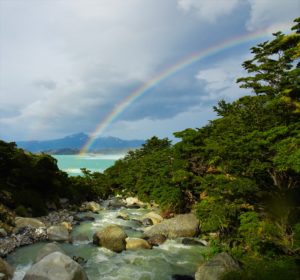
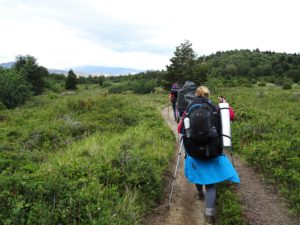
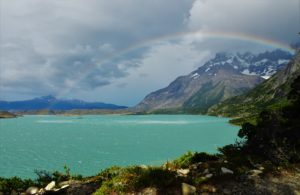


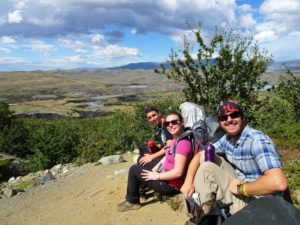
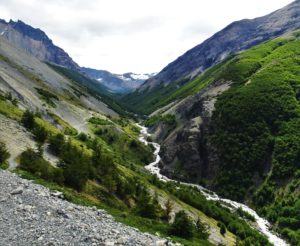
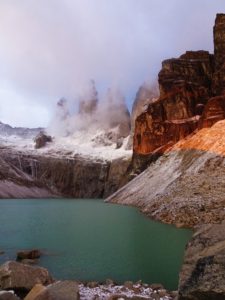
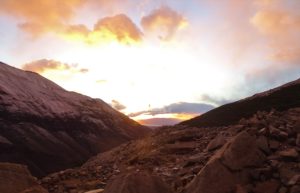
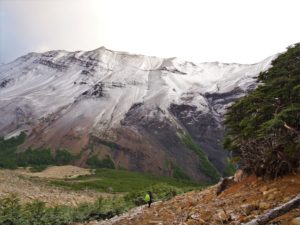
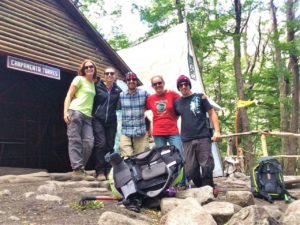

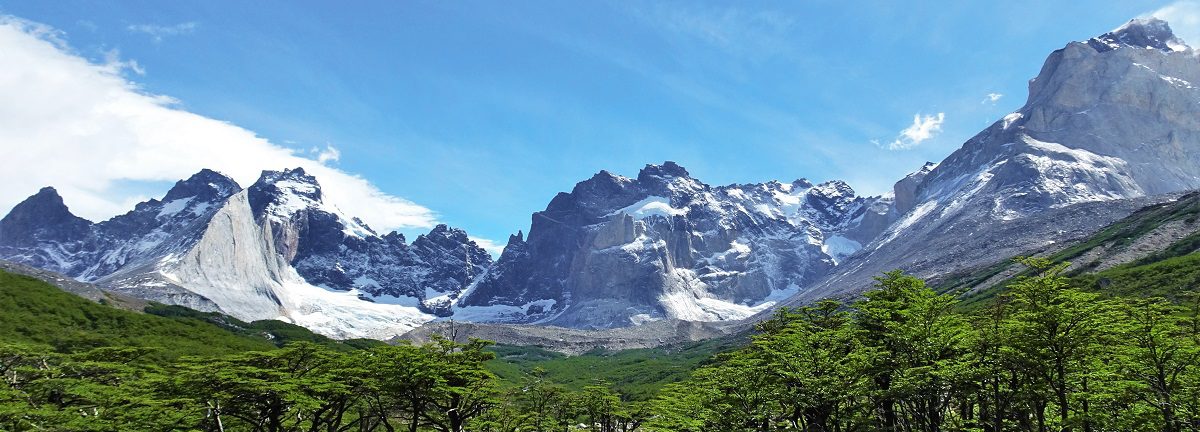
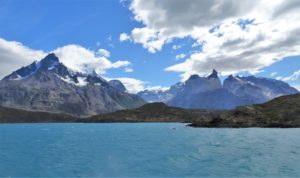
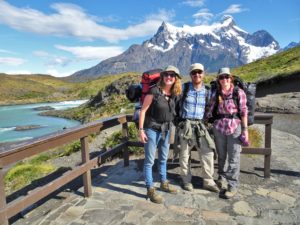
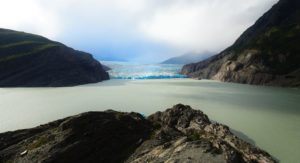
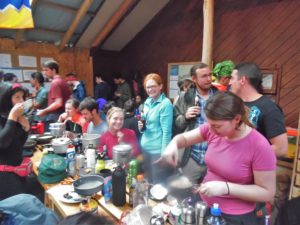
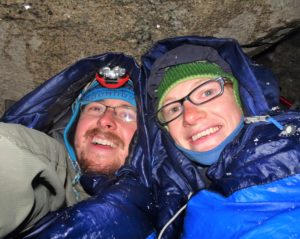
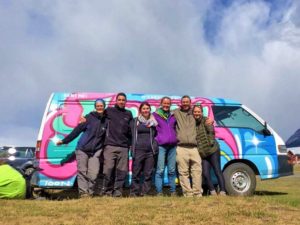
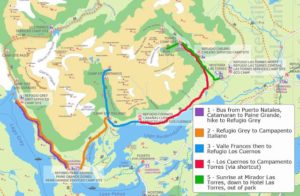
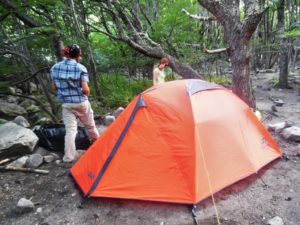
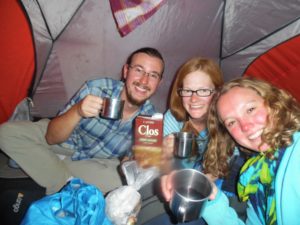
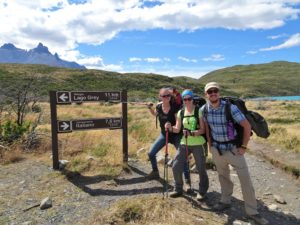
Mmm, chocolate multi coloured porridge, maybe worth doing the trek for that alone! Looks like the D of E experience really paid off!xxx